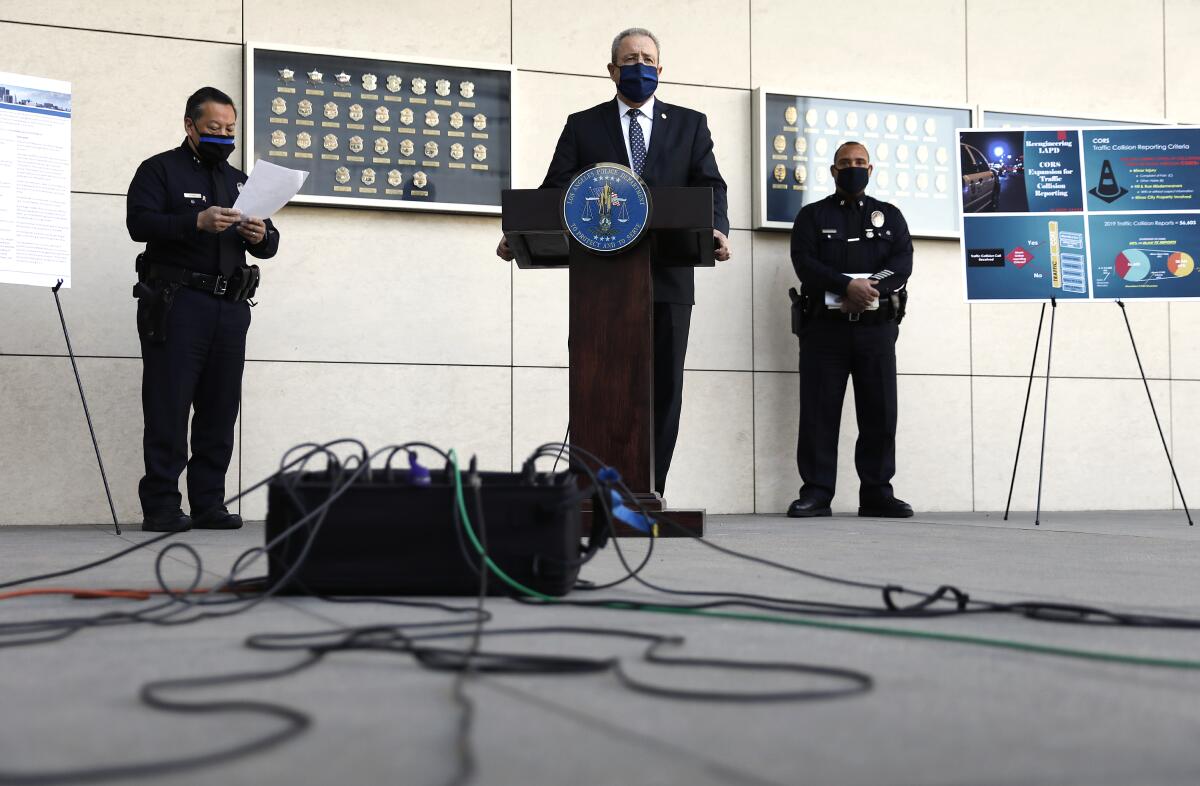Push and pull over Los Angeles policing hits roadways and transit

- Share via
The ongoing debate over policing levels in Los Angeles centered on the transportation sector Thursday as Metro officials considered paying for more officers on the city’s transit system and the Los Angeles Police Department announced it would no longer send officers to minor traffic collisions.
The two discussions reflected the shifting landscape for law enforcement in L.A. at a time of intense violence and changing public safety priorities, when homicides are at a decade high but protesters’ summer calls for defunding police continue to resonate among elected officials and other leaders.
They followed a Board of Education decision two days earlier to cut a third of officers from the Los Angeles School Police Department.
Under a proposal taken up by Metro’s safety committee Thursday, the agency would expand its security contracts with the LAPD, the L.A. County Sheriff’s Department and Long Beach Police Department by a combined $111 million. Metro officials said the funding was necessary for security initiatives and deployments the agency had already requested from the police agencies, including ramped-up patrols on transit lines where crime has persisted at pre-pandemic levels despite the system’s loss of more than half its ridership.
Bob Green, the transit system’s chief law enforcement officer, said that a recent survey of riders suggested security was a top concern, and that the contract increases would help to ensure it improves.
Under the “best-case scenario” at the moment, two officers work every three stations on the Red Line, and it isn’t enough to maintain safety or ensure swift responses when crimes occur. Officers have stumbled upon sexual assaults in progress, he said.
“People are getting victimized seriously on the system,” Green said.
However, the Metro committee — consisting of elected officials and appointees — seemed unconvinced that more police was the answer, particularly after people who had called into the public hearing blasted the plan as ill-conceived and out of step with public sentiment.
Advocates from Black Lives Matter-Los Angeles and other community and transit advocacy groups said Metro officials, including Chief Executive Phillip Washington, were backtracking on promises last summer to reduce policing on the system, all in an attempt to crack down on issues of homelessness and mental illness that should have nothing to do with police.
They said Metro should focus instead on connecting homeless and ill riders with social services, and on restoring overall ridership to pre-pandemic levels because riders make buses and trains safe, not police.
“Every time I’ve been on a bus or a train and there was some kind of issue, I’ll tell you right now, the people who de-escalated the issue were other riders,” said David Turner, manager of the Brothers, Sons, Selves Coalition, which works with youths in communities of color.
Ricci Sergienko, an organizer with the People’s City Council — an activist group that pushed the City Council to defund the LAPD last summer — said the contracts to increase police spending on transit represented a move in the wrong direction, against the will of residents.
“People in Los Angeles are saying ‘defund the police.’ That means do not give the police money,” he said.
After public comment, committee members reiterated reservations they had with the contract increases — which would add more than $60 million for LAPD officers, more than $44 million for sheriff’s deputies and more than $6.8 million for Long Beach officers — and decided not to recommend approval of the contract, but instead send it to the full Metro board for a fuller discussion among all members at a later date.
About an hour later, LAPD Chief Michel Moore stood before police headquarters downtown to tout several initiatives to reduce deployments of armed LAPD officers to nonviolent incidents, including minor traffic collisions.
Moore said the effort was spurred by a “call to action” from officials since last summer’s protests for police to find ways to step back from certain roles, and would help the department deal with a reduction in its force that resulted from an associated decision by the City Council to cut its budget by $150 million.
Under the new approach, LAPD officers will no longer respond to calls from motorists who have been involved in accidents that resulted in minor damage or injuries, but will still respond to accidents involving serious injuries or crimes such as drunken driving. For minor incidents, motorists will instead be directed to fill out an online form to meet state obligations for reporting traffic incidents.
Deputy Chief Blake Chow, commander of the LAPD’s Transit Services Bureau, said the new program could redirect about 40,000 calls a year and save 160,000 hours of police work that could be recommitted into patrol and other crucial services.
Along with other new programs to divert nonviolent calls related to mental illness and suicidal ideation to mental health providers and increase responses to other mental health incidents by dual teams of officers and clinicians, Moore said, the traffic program puts the department on the right course — honing the role of officers more closely to crime prevention and response, rather than social services.
Still, much more needs to be done to provide social service alternatives to policing, including by scaling up city and county pilot programs aimed at mental health and homelessness response, Moore said.
“The next step forward, and this is critical, is for our county and city leadership to build and deepen the non-law-enforcement resources that are necessary to handle the tens of thousands of additional calls that LAPD is currently handling,” Moore said. “In plain language, we need outreach workers, mental health professionals ... that are in the field and available and seeking work 24 hours a day, seven days a week.”
More to Read
Sign up for Essential California
The most important California stories and recommendations in your inbox every morning.
You may occasionally receive promotional content from the Los Angeles Times.











